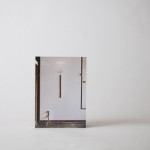September, 2010
Fredensborg House by Norm Architects

The Fredensborg House designed by Danish Architect firm Norm Architects it is an exploration of high contrast, natural materials, and strategic light placement.
The High contrast is easily seen through the use of light materials and white walls contrasted with black furniture and accessories, but more immediately the contrast between the facade of the house and the beautiful minimalist interior.
In this photo we can see a three piece Henning Koppel weather station mounted on the wall above the rain boots.

A simple white kitchen with white stained floors. On the counter is one of our favorite modernist objects: The Kubus candleholder, by Danish designer Mogens Lassen.

The architects explains:
“One of the main goals for this house is to provide a feeling of serenity and calm. To achieve this goal, the use of different contrasting materials was minimized. And to suit the elements of the buildings surroundings and staying true to its natural form, a lot of local materials were used.”

As I mentioned earlier there are three main explorations of the house, the third is strategic lighting.

Classic Danish PK22 chairs and coffee table by Poul Kjaerholm.

via Design-Milk
Icelandic pottery

We never really got around to sharing the Icelandic pottery we found during our trip to Iceland. We got this little vase from an antique shop called Fríða Frænka in Reykjavik. It’s a simple shape with an interesting texture.
There were some pretty neat lava vases which were really textured, but the colours were a bit to intense for us.

The bottom is stamped “Glit” a ceramics studio founded by Ragnar Kjartansson in 1958. I don’t think it exists anymore, but there was another studio producing similar “lava” vases that we poked our heads into during the trip.
Mount Fuji Architects Studio

During our trip to Tokyo we stumbled across this house in Meguro. The amazing architecture firm Mount Fuji Architects Studio has been making the blog rounds recently and I decided to visit their website to take a look at their other work.

I was pleasantly surprised to see the very same house we came across as one of their projects, plus we get to take a look at the inside!

During the day the glass has a mirror finish, but at night is where you can get a glimpse at the house’s interior.

The exposed wooden frame which is also used as shelves providing a practical element to the structure.
We love the use of natural material: stone, concrete, wood, and glass. Simple timeless materials.

There is also a great use of light in the space through multiple windows and entry points.

A beautiful wooden handrail.


After the owners moved in there were a few more images taken with their furnishings in place.
You can see there is a lot of light coming from all sides of the house, but there are also wooden screens providing privacy.

via Arch Daily
Naoto Fukasawa’s notebook

An intimate look into Naoto Fukasawa’s notebook:
Detour Exhibition – Naoto Fukasawa
via minimalissimo
Kitka’s office supplies

We’ve been anticipating this post ever since we started working on the office. Over the years for some reason I’ve been collecting modernist office accessories for the day where I could have my own minimalist Dieter Rams style office.
Enjoy!

Braun ET55 calculator, designed by Dietrich Lubs & Dieter Rams.

Plus Minus Zero calculator & Lamy ballpoint pens, designed by Naoto Fukasawa.

Braun desk fan, designed by Reinold Weiss (1961).

I have to give a bit of a shout out to Lawrence from Atomic on this one. He has one on his desk and every time I visit I coveted it, until I recently found one with N. American voltage on ebay.

I just received “White” by Japanese designer Kenya Hara.

It’s a quick read, but maybe I’ll get to use the Angular bookmark designed by Folmer Christensen.
Now available at the Mjolk Shop. Let me introduce you to the rest of the line:

Ruler, designed by Folmer Christensen.

Paper knife, designed by Folmer Christensen. Winner of the Form 91 award (Frankfurt).

26/6 Stapler, designed by Henning Andreasen. Awarded the Danish Design Council’s ID prize and included in the Industrial Design Collection at the Museum of Modern Art.

The only stapler you will ever need.

Pen tray with calender, designed by Folmer Christensen.

A couple of new additions to the office (paper tray and coffee maker to complete the collection).

Super fluffy Isha.
Elekit tube amp

+
Even though this tube amp was originally featured in Dezeen last year, it recently made an appearance in Notcot and was so striking I just had to share it.

Back in 2008 Japanese designer Koichi Futatsumata, founder of Case-Real studio, was commisioned to design a tube amp for Elekit Japan whose company develops numerous electronic amplifier kits targeted at both children and adults. The request was for Case-Real studio to design an amplifier marketed to a younger generation who are novice about tube amplifiers, but are naively interested in the charm and atmosphere created by one.

The result is a strikingly minimalist masterpiece which begs the question: If you commission an amazing design firm to make a prototype for your company, why doesn’t it go into production?


